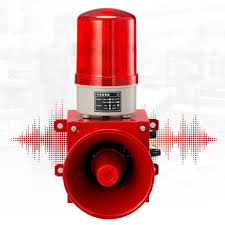An alarm bell is an audible signaling device that produces a distinct ringing sound to alert and warn people about potential dangers, emergency situations, or critical events. Alarm bells have been used for centuries as effective warning devices and are still in use today in various applications. Here are some types of alarm bells:
1. Mechanical Alarm Bell: Traditional alarm bells that use a mechanical mechanism, often with a clapper striking the bell to create the ringing sound. They are commonly found in historical buildings, schools, and older fire alarm systems.
2. Electric Alarm Bell: Electrically operated alarm bells that are connected to an electrical circuit. When the circuit is activated, the electromagnet inside the bell causes the clapper to strike the bell, producing the ringing sound. Electric alarm bells are widely used in modern fire alarm systems, industrial facilities, and security systems.
3. Electronic Alarm Bell: These are modern versions of alarm bells that use electronic components to produce the ringing sound. They are more compact, energy-efficient, and may offer additional features like adjustable volume levels and different sound patterns.
4. Motor-Driven Alarm Bell: These alarm bells use a motor to rotate a striking mechanism, creating the ringing sound. They are often used in larger industrial settings where a louder and more sustained alarm is required.
5. Outdoor Alarm Bell: These alarm bells are designed to withstand harsh weather conditions and are used in outdoor applications, such as large industrial sites, construction sites, or public areas.
6. Marine Alarm Bell: Specifically designed for marine applications, these alarm bells are built to withstand the corrosive environment of sea vessels and are used for signaling emergencies or navigation alerts.
The choice of alarm bell type depends on the specific application, desired sound level, environment, and regulatory requirements. Alarm bells are commonly used in fire alarm systems, emergency warning systems, security systems, industrial plants, and public buildings to provide audible alerts and ensure the safety and well-being of people in those locations.
Horns are audible signaling devices that produce loud sounds to alert and warn people in various situations. They are commonly used for safety, emergency signaling, and communication purposes in different settings. Here are some types of horns:
1. Air Horn: Air horns, also known as pneumatic horns, operate by using compressed air to create a loud and attention-grabbing sound. They are commonly used in marine environments, sports events, and as warning devices in industrial settings.
2. Electric Horn: Electric horns are powered by electricity and use electromagnets to create sound vibrations. They are widely used in automotive vehicles, ships, industrial machinery, and as part of fire alarm systems.
3. Handheld Horn: Handheld horns are portable devices that can be operated manually to produce a loud sound. They are commonly used in sports events, boating, and outdoor activities.
4. Mechanical Horn: Mechanical horns use a manual lever or pump to generate sound. They are often found in older vehicles, bicycles, and manual signaling devices.
5. Truck Horn: Truck horns are large and powerful horns commonly used in commercial trucks and heavy-duty vehicles. They produce a deep and loud sound for signaling purposes.
6. Bicycle Horn: Bicycle horns are compact and lightweight horns designed for bicycles to provide an audible signal for safety and communication with pedestrians and other cyclists.
7. Musical Air Horn: Some specialty horns are designed to play specific musical notes or tunes. They are used for entertainment purposes, sporting events, and celebrations.
The choice of horn type depends on the specific application, desired sound level, and the environment where it will be used. Horns are essential for providing warning signals and ensuring safety in various situations, such as on roads, waterways, industrial facilities, and public events.
